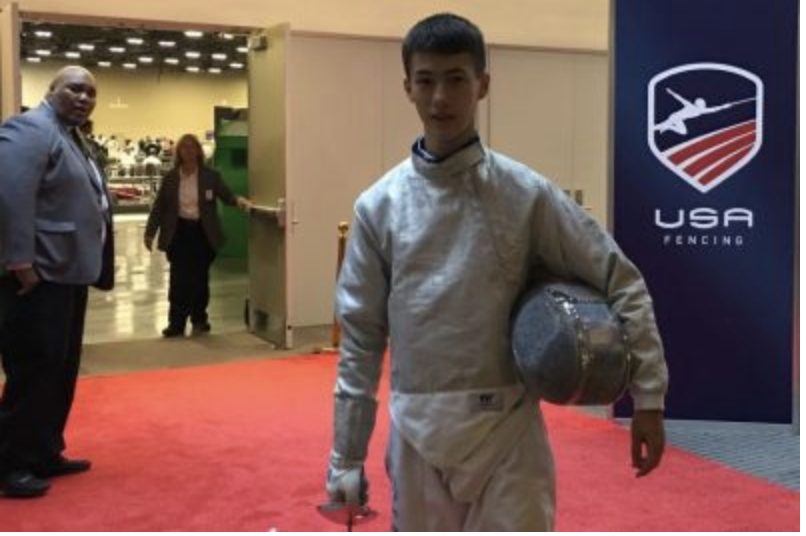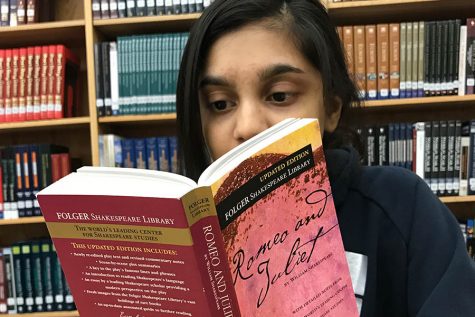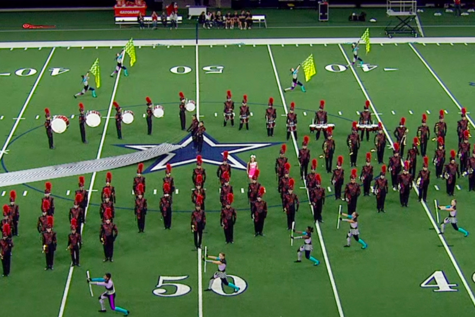Ready, set, en garde: junior rediscovers passion for fencing
Junior Chelan McNear’s fencing journey has been met with moments of losing motivation. However, because of his abilities as well as determination, D’Asaro hopes Chelan can demonstrate more of his skills and continue to participate in fencing throughout college.
Foil.
Épée.
Sabre.
In fencing, each of the three weapons have different compositions, techniques, and target areas, causing most fencers to choose to specialize in only one discipline early on in their career.
Yet, for junior Chelan McNear, finding the right weapon to pursue took longer than he had expected.
When he was 6-years-old, McNear was first introduced to fencing through the use of plastic swords.
My first fencing experience was in first grade. In China, middle school spanned from first grade all the way to sixth grade,
— junior Chelan Mcnear
“My first fencing experience was in first grade. In China, middle school spanned from first grade all the way to sixth grade,” McNear said. “I joined a fencing club that was in our school and they taught us the basics of foil. They didn’t give us real foil blades back then. [Instead], it was a plastic sword with a button at the end, and every time you poked somebody with it, [the sword] made a sound.”
However, even as he found using plastic swords enjoyable, McNear lost interest in continuing the sport until he was the age of nine.
“After second grade, the whole fencing deal died down. I didn’t fence for a long time,” McNear said. “[However], it wasn’t until I moved to the Philippines in fourth grade. There was a fencing coach in my country club – The Palms Country Club – and every Saturday, I would go there and fence. The coach there taught foil and épée: two divisions of fencing that you can only stab people with the sword.”
Regardless of how long he trained though, McNear felt that he wasn’t making any improvements as he was one of the only individuals who practiced with foil.
“I practiced with him for a year and a half, but I wasn’t making any progress since most of the kids there all fenced épée,” McNear said. “[Because] I didn’t have the chance to fence against other kids, I went on a plateau and stopped.”
However, when he arrived in the United States in eighth grade, McNear had received another opportunity to fence.
“I asked friends in the area if they had any information on fencing clubs,” Chelan’s mom Laura said. “One friend recommended Kairos in Plano that was near enough for daily training.”
Even so, he had to learn a whole new weapon.
“I went for the first time to Kairos Fencing Academy and I met Coach Chris who only coached sabre,” McnNear said. “When I went there, I knew some of the fundamental footwork [of sabre], but it was so different from épée and foil that I had to relearn the sport.”
Despite qualifying for Summer Nationals in Columbus, OH during the summer between eighth grade and ninth grade McNear began to lose motivation once again.
I reached a plateau when the pandemic started. I was getting dejected about fencing because I didn’t feel I was making a lot of progress,
— junior Chelan McNear
“I reached a plateau when the pandemic started. I was getting dejected about fencing because I didn’t feel I was making a lot of progress,” McNear said. “I didn’t fence through the end of ninth grade, and in tenth grade, I didn’t fence as well. I could’ve gone back at some point, but [because] I’ve been gone for so long, I felt that I didn’t know how to make more progress.”
The following year, McNear found his enthusiasm and drive for fencing once more and joined the Fencing Institute of Texas where he quickly adapted to the new facility and coaching styles.
“I acclimated to the new environment pretty quickly and I like having three coaches – Coach Mike, Coach Kyle, and Coach Ronda – as I get a lot more opinions,” McNear said. “There are also far more older kids in this club than Coach Chris’ because with the amount of kids he had, his attention was really divided each day. [I believe] I have progressed a lot with my fencing skills in this club.”
McNear’s coach, Micahel D’Asaro was able to incorporate new styles into McNear’s fencing repertoire.
“Chelan came to me from another coach. His first coach is also very good. But I remember him when he competed and I know his coach who taught a very rigid Russian style. I teach more fluid movement and a lot of strategy with the distance and footwork. Not as much bladework,” D’Asaro said. “Chelan has come a long way, but still has more to go. It’s tough switching coaches and styles. But Chelan is smart and understands the subtle differences between the two of us. He is getting more aggressive and moving much better.”
I think that once college coaches see what he can do, they would be very interested in bringing him to their schools,
— McNear’s coach Micahel D’Asaro
Because of his abilities as well as determination, D’Asaro hopes Chelan can demonstrate more of his skills and continue to participate in fencing throughout college.
“What I would like him to do is get to more tournaments and compete more,” D’Asaro said. “I think that once college coaches see what he can do, they would be very interested in bringing him to their schools. Many high level colleges have fencing teams and are actively recruiting. Many of my students go to Columbia, Princeton, Stanford and other high level schools on fencing scholarships. Lots of schools have NCAA fencing teams. Others have clubs. So I’m hoping he’ll be fencing in college.”

Rachel Kim is a senior and is entering her second year of Wingspan. Outside of school, she probably can be seen at a coffee shop or at home reading her...












